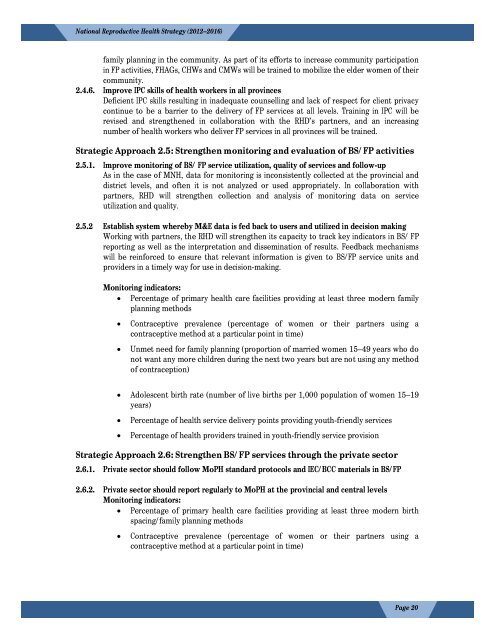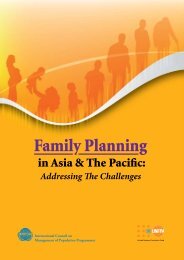national reproductive health strategy - Ministry of Public Health ...
national reproductive health strategy - Ministry of Public Health ...
national reproductive health strategy - Ministry of Public Health ...
You also want an ePaper? Increase the reach of your titles
YUMPU automatically turns print PDFs into web optimized ePapers that Google loves.
National Reproductive <strong>Health</strong> Strategy (2012–2016)family planning in the community. As part <strong>of</strong> its efforts to increase community participationin FP activities, FHAGs, CHWs and CMWs will be trained to mobilize the elder women <strong>of</strong> theircommunity.2.4.6. Improve IPC skills <strong>of</strong> <strong>health</strong> workers in all provincesDeficient IPC skills resulting in inadequate counselling and lack <strong>of</strong> respect for client privacycontinue to be a barrier to the delivery <strong>of</strong> FP services at all levels. Training in IPC will berevised and strengthened in collaboration with the RHD’s partners, and an increasingnumber <strong>of</strong> <strong>health</strong> workers who deliver FP services in all provinces will be trained.Strategic Approach 2.5: Strengthen monitoring and evaluation <strong>of</strong> BS/FP activities2.5.1. Improve monitoring <strong>of</strong> BS/ FP service utilization, quality <strong>of</strong> services and follow-upAs in the case <strong>of</strong> MNH, data for monitoring is inconsistently collected at the provincial anddistrict levels, and <strong>of</strong>ten it is not analyzed or used appropriately. In collaboration withpartners, RHD will strengthen collection and analysis <strong>of</strong> monitoring data on serviceutilization and quality.2.5.2 Establish system whereby M&E data is fed back to users and utilized in decision makingWorking with partners, the RHD will strengthen its capacity to track key indicators in BS/ FPreporting as well as the interpretation and dissemination <strong>of</strong> results. Feedback mechanismswill be reinforced to ensure that relevant information is given to BS/FP service units andproviders in a timely way for use in decision-making.Monitoring indicators: Percentage <strong>of</strong> primary <strong>health</strong> care facilities providing at least three modern familyplanning methodsContraceptive prevalence (percentage <strong>of</strong> women or their partners using acontraceptive method at a particular point in time)Unmet need for family planning (proportion <strong>of</strong> married women 15–49 years who donot want any more children during the next two years but are not using any method<strong>of</strong> contraception) Adolescent birth rate (number <strong>of</strong> live births per 1,000 population <strong>of</strong> women 15–19years)Percentage <strong>of</strong> <strong>health</strong> service delivery points providing youth-friendly servicesPercentage <strong>of</strong> <strong>health</strong> providers trained in youth-friendly service provisionStrategic Approach 2.6: Strengthen BS/FP services through the private sector2.6.1. Private sector should follow MoPH standard protocols and IEC/BCC materials in BS/FP2.6.2. Private sector should report regularly to MoPH at the provincial and central levelsMonitoring indicators: Percentage <strong>of</strong> primary <strong>health</strong> care facilities providing at least three modern birthspacing/family planning methodsContraceptive prevalence (percentage <strong>of</strong> women or their partners using acontraceptive method at a particular point in time)Page 20














